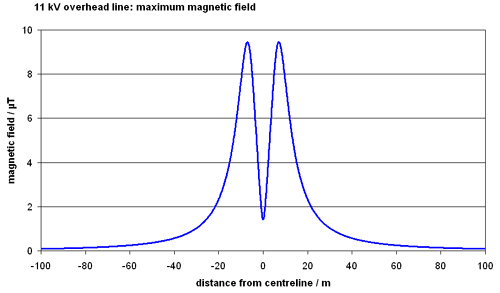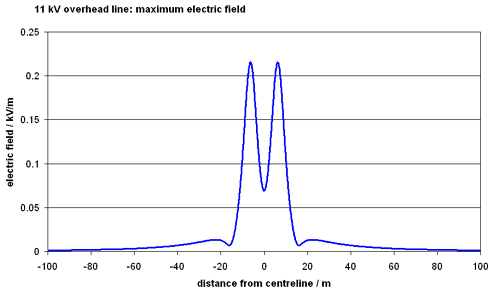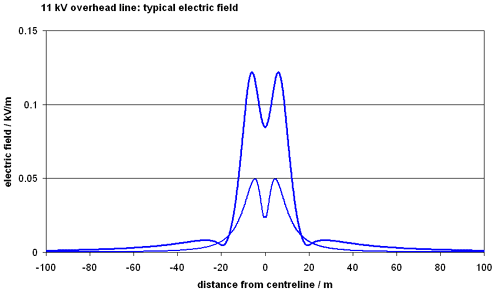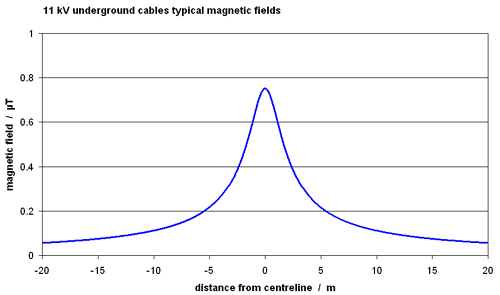11 kV lines are either carried on small lattice steel pylons or on wood poles. There are many different variants of lines design but they all produce roughly similar fields.
Magnetic field
The maximum field shown here is produced by a lattice pylon design when the ground clearance is the minimum allowed – 5.5 m – and the loads are the highest allowed – not usually above 500 A in each circuit but there may be exceptions. The field also depends on the phasing. 11 kV lines usually have Untransposed (U) phasing.

Typical fields are lower than the maximum field because the clearance is usually higher and the loads are usually lower. The two curves shown here are for typical loads, the normal U phasing, and two different line designs: a lattice steel pylon (the higher field), and a wood-pole design (the lower field).

This table gives some actual field values for the same conditions.
magnetic field in microtesla at distance from centreline | |||||||||
|---|---|---|---|---|---|---|---|---|---|
maximum under line | 10 m | 25 m | 50 m | 100 m | |||||
11 kV | larger lines on steel pylons | SL11 single conductors | maximum | clearance 5.5 m | 9.456 | 7.664 | 1.490 | 0.364 | 0.090 |
typical | clearance 8 m | 1.004 | 0.942 | 0.274 | 0.071 | 0.018 | |||
smaller lines on wood poles | wood pole horizontal array +-1.15 m | maximum | clearance 5.5 m | 3.744 | 0.668 | 0.124 | 0.032 | 0.008 | |
typical | clearance 8 m | 0.399 | 0.134 | 0.030 | 0.008 | 0.002 | |||
Note:
1. All fields calculated at 1 m above ground level.
2. All fields are given to the same resolution for simplicity of presentation (1 nT = 0.001 µT) but are not accurate to better than a few percent.
3. Calculations ignore zero-sequence current. This means values at larger distances are probably underestimates, but this is unlikely to amount to more than a few percent and less closer to the line.
4. The “maximum field under the line” is the largest field, which is not necessarily on the route centreline; it is often under one of the conductor bundles.
5. Sometimes, an 11 kV circuit could be carried on a line designed for a higher voltage. Then the magnetic fields could be larger than shown here.
6. The dip in field on the centreline between the two circuits happens when the two circuits are carrying the same load, and is less pronounced if the loads are different.
Electric field
The maximum field shown here is produced by a lattice pylon design when the ground clearance is the minimum allowed – 5.5 m. The field also depends on the phasing. 11 kV lines usually have Untransposed (U) phasing.

Typical fields are lower than the maximum field because the clearance is usually higher. The two curves shown here are for the normal U phasing and two different line designs: a lattice steel pylon (the higher field), and a wood-pole design (the lower field).

This table gives some actual field values for the same conditions.
electric field in V m-1 at distance from centreline | |||||||||
|---|---|---|---|---|---|---|---|---|---|
maximum under line | 10 m | 25 m | 50 m | 100 m | |||||
11 kV | larger lines on steel pylons | SL11 single conductors | maximum | clearance 5.5 m | 215 | 109 | 13 | 5 | 1 |
typical | clearance 8 m | 122 | 82 | 8 | 4 | 1 | |||
smaller lines on wood poles | wood pole horizontal array +-1.15 m | maximum | clearance 5.5 m | 108 | 32 | 3 | 0 | 0 | |
typical | clearance 8 m | 50 | 29 | 4 | 1 | 0 | |||
Note:
1. All fields calculated at 1 m above ground level.
2. All electric fields are calculated for the nominal voltage. In practice, voltages (and hence fields) may rise by a few percent.
3. All electric fields calculated here are unperturbed values.
4. All fields are given to the same resolution for simplicity of presentation (1 V/m) but are not accurate to better than a few percent.
5. Calculations ignore zero-sequence voltages. This means values at larger distances are probably underestimates, but this is unlikely to amount to more than a few percent and less closer to the line.
6. The “maximum field under the line” is the largest field, which is not necessarily on the route centreline; it is often under one of the conductor bundles.
7. Sometimes, an 11 kV circuit could be carried on a line designed for a higher voltage. Then the electric fields could be larger than shown here.
Underground cables
11 kV underground cables are usually a single cable: the three cores are twisted round each other in a single outer sheath. Because the cores are so close together and twisted, the fields they produce directly are very small. Instead, the field comes from any net current in the sheath. This is very variable and cannot be predicted accurately.
The following graph shows typical fields from the net current in a 11 kV cable.

Occasionally an 11 kV cable may have separate cores. Then the field would be more like a 132 kV cable with separate cores.
Underground cables do not produce any external electric fields.
This table gives some actual field values for the same conditions.
magnetic field in microtesla at distance from centreline | |||||||
|---|---|---|---|---|---|---|---|
0 m | 5 m | 10 m | 20 m | ||||
11 kV | single cable | 0.5 m depth | typical | 0.75 | 0.22 | 0.11 | 0.06 |
Notes
1. All fields calculated at 1 m above ground level
2. All fields are given to the same resolution for simplicity of presentation (0.01 µT = 10 nT) but are not accurate to better than a few percent.
3. These calculations are for a single, isolated cable. This is rare in practice. Other nearby cables would modify the field.
